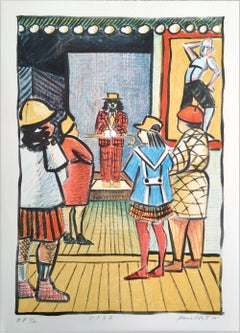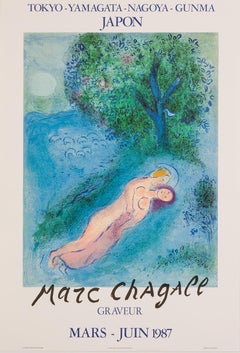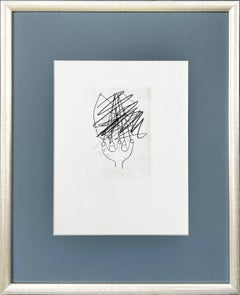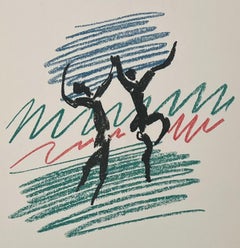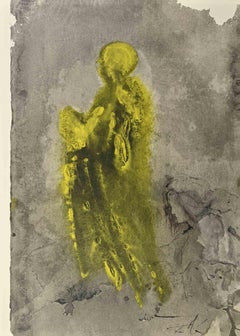Vertical More Prints
to
479
1,570
1,032
1,308
608
359
Overall Width
to
Overall Height
to
1,137
811
509
457
376
78
67
53
42
22
15
13
11
11
322
181
143
120
93
105
301
3,110
1,360
24
47
53
76
199
284
600
721
347
244
96
4,877
2,502
743
165
113
102
84
61
57
49
41
33
30
23
19
18
12
12
10
10
9
8
8
2,150
882
603
591
423
768
1,290
2,217
2,174
Orientation: Vertical
C F S I, Signed Lithograph, Coney Island, Comic Character Figures
By Marie Roberts
Located in Union City, NJ
C F S I is an original hand drawn lithograph by the New York woman artist Marie Roberts printed using hand lithography techniques on archival Arches paper 100% acid free. C F S I portrays a Coney Island Sideshow Performance with several onlookers standing by the stage watching the show. C F S I is a skillfully expressed comic character figure drawing printed in black ink shaded with colored crayon line textures in shades of red, yellow and blue. C F S I is a very fine impression exemplifying the magic and artistic mastery of hand crafted lithography with its nuanced tusche brush strokes and pencil crayon line textures and shading.
Print size - 29.5 x 21.25 in, unframed, excellent condition, hand signed in pencil by Marie Roberts
Image size - 26.25 x 18.25 in
Year published - 1995
Edition size - 25
Marie Roberts, a Coney Island native is best known for her banners for the Coney Island Circus Sideshow...
Category
1990s Contemporary Figurative Prints
Materials
Lithograph
La Lecon de Philetas, Les Amoureux Devant l'Arbre Exhibition Poster
Located in New York, NY
This original 1987 exhibition poster was created for an exhibition of works by Marc Chagall which travelled Japan (Tokyo, Yamagata, Nagoya and Gunma). It was printed in Paris by the ...
Category
Late 20th Century Modern Figurative Prints
Materials
Lithograph
The Taste of Happiness, Planche XLIV
Located in OPOLE, PL
Pablo Picasso (1881-1973) - The Taste of Happiness, Planche XLIV
Lithograph from 1970.
An unsigned and unnumbered edition of 666.
Dimensions of sheet: 32.5 x 25 cm
Dimensions in ...
Category
1970s Modern More Prints
Materials
Lithograph
La Danse, frontispiece from Picasso Lithographe III
Located in Washington, DC
Artist: Pablo Picasso
Title: La Danse (frontispiece)
Portfolio: Picasso Lithographe III
Medium: Transfer lithograph printed in colors
Date: 1956
Edition: 3000
Frame Size: 19 1/2" x 1...
Category
1950s Modern Abstract Prints
Materials
Lithograph
Katsura Rikyu-Kyoto
Located in OPOLE, PL
Bernard Buffet (1928-1999) - Katsura Rikyu-Kyoto
Lithograph from 1981.
Artsit's edition.
On Arches paper.
Dimensions of work: 71 x 53.5 cm.
Hand signed.
The work is in Excellen...
Category
1980s Expressionist More Prints
Materials
Lithograph
Don't Touch Me - Lithograph - 1964
Located in Roma, IT
Don't Touch Me is Color lithograph on heavy rag paper realized in 1964. It is part of Biblia Sacra vulgatæ edition is published by Rizzoli-Mediolani between 1967 and 1969.
Signed an...
Category
1960s Surrealist More Prints
Materials
Lithograph
L'Hibou Rouge
By Karel Appel
Located in New York, NY
A very good impression of this color lithograph on Arches. Artist's proof, aside from the edition of 75. Signed, dated and inscribed "ea" in pencil by Appel.
Category
1960s Modern Abstract Prints
Materials
Color, Lithograph
As I Opened Fire Poster, Triptych
Located in New York, NY
Set of 3 color offset lithographs. The last panel is signed in pencil. Printed by Drukkerij Luii & Co., Amsterdam. Published by the Stedelijk Museum, Amsterdam. This is a reproductio...
Category
1960s Pop Art Abstract Prints
Materials
Color, Lithograph, Offset
Exhibition Poster Galerie Gerald Cramer - Lithograph by Joan Mirò - 1969
By Joan Miró
Located in Roma, IT
Exhibition Poster Galerie Gerald Cramer is a contemporary artwork realized by Joan Mirò.
Mixed colored lithograph.
The poster was realized in occasion of the exhibition of the arti...
Category
1960s Surrealist More Prints
Materials
Lithograph
Jean Cocteau - Olé - Original Lithograph
By Jean Cocteau
Located in Collonge Bellerive, Geneve, CH
Jean Cocteau - Olé - Original Lithograph
1934
Signed and dated in the plate
Numbered in pencil
Edition : /200
Dimensions: 50 x 33 cm
Provenance : Succession Dermit, Cocteau's heir
Category
1930s Modern More Prints
Materials
Lithograph
Urbi
Located in OPOLE, PL
Pablo Picasso (1881-1973) - Urbi
Phototype and pochoir from 1962.
From the edition of 1,000 copies, this example is number 334, as noted in the colophon.
Dimensions of sheet: 40 x...
Category
1960s Modern More Prints
Materials
Stencil
Oracle: Study for Clairvoyant
Located in New York, NY
Seymour Lipton
Oracle: Study for Clairvoyant, 1969
Lithograph on wove paper
24 1/2 × 18 inches
Pencil signed "Lipton" lower right recto Pencil numbered 44/100, lower left recto pencil titled and dated, verso
Unframed
Uncommon mid century modern pencil signed and numbered lithograph by renowned abstract expressionist sculptor Seymour Lipton. "Study for Clairvoyant", also known as "Oracle", is a study for a famous monumental modernist masterpiece by Lipton. Other editions of this lithograph are in major collections such as that of the Brooklyn Museum. Rarely to market.
Provenance: Swann Galleries
Category
1960s Abstract Expressionist Abstract Prints
Materials
Lithograph
Acrobats at Play
By Marc Chagall
Located in OPOLE, PL
Marc Chagall (1887-1985) - Acrobats at Play
Original Lithograph from 1960.
Dimensions of work: 32 x 24 cm.
Publisher: Maeght Éditeur, Paris.
The work is in Excellent condition.
Category
1960s Modern More Prints
Materials
Lithograph
Elisabeth - Contemporary figurative Print, Pop art, Polish artist
Located in Warsaw, PL
*** Please note: Pictures of print in frame are only a visualization. Artwork is sold unframed
DANUTA DĄBROWSKA-SIEMASZKIEWICZ Painter and graphic artist. Her works have been publis...
Category
20th Century Other Art Style Figurative Prints
Materials
Paper, Screen
World War 2 original propaganda poster - Loose Talk Can Cost Lives
By Howard Scott
Located in London, GB
Howard Scott
Loose Talk Can Cost Lives
Lithograph
51 x 36 cm
'Closed for the duration...Loose talk can cost lives.'
In both the United Kingdom and the United States, there was a ...
Category
1940s Realist More Prints
Materials
Lithograph
Jonas Wood Face Painting Print Dallas Museum Of Art Kids Contemporary Street Art
By Jonas Wood
Located in Draper, UT
TITLE
Jonas Wood Face Painting Print Dallas Museum Of Art
YEAR
2019
CLASSIFICATION
MEDIUM TYPE
Print
MEDIUM/MATERIALS
Thick Stock Fine Art Pa...
Category
2010s Contemporary More Prints
Materials
Lithograph
The Clown with Flowers
By Marc Chagall
Located in OPOLE, PL
Marc Chagall (1887-1985) - The Clown with Flowers
Original Lithograph from 1960.
Dimensions of work: 32 x 24 cm.
Publisher: Maeght Éditeur, Paris.
The work is in Excellent condit...
Category
1960s Modern More Prints
Materials
Lithograph
Sill Life - Original Lithograph by Ivo Pannaggi - 1975 ca.
By Ivo Pannaggi
Located in Roma, IT
Image dimensions: 54 x 40 cm.
Still Life is a beautiful and rare lithograph realized by the artist Ivo Pannaggi in a circulation of 100 copies around 197...
Category
1970s Futurist More Prints
Materials
Lithograph
The Resurrection
Located in New York, NY
The Resurrection by Salvador Dali
Spanish (1904–1989)
Date: 1979
Lithograph on Arches, signed and numbered in pencil
Edition 186/250
Image Size: 23 x 16 inches
Size: 29.5 x 21.5...
Category
20th Century Surrealist More Prints
Materials
Lithograph
Jean Dubuffet - La Mouche - Original Screenprint
Located in Collonge Bellerive, Geneve, CH
Jean Dubuffet
Banque de L'Hourloupe
Original Card with a title card
Original edition of 350 numbered sets with 30 hors commerce
Dimensions: 25 x 16 cm
Screen printed by Kelpra Studios, London Editions Alecto, London 1967
Jean Dubuffet (1901 - 1985)
Jean Dubuffet was born on July 31, 1901, in Le Havre, France. He attended art classes in his youth and in 1918 moved to Paris to study at the Académie Julian, which he left after six months. During this time, Dubuffet met Raoul Dufy, Max Jacob, Fernand Léger, and Suzanne Valadon and became fascinated with Hans Prinzhorn's book on psychopathic art. He traveled to Italy in 1923 and South America in 1924. Then Dubuffet gave up painting for about ten years, working as an industrial draftsman and later in the family wine business. He committed himself to becoming an artist in 1942.
Dubuffet's first solo exhibition was held at the Galerie René Drouin, Paris, in 1944; the Pierre Matisse Gallery gave him his first solo show in New York in 1947. During the 1940s, the artist associated with André Breton, Georges Limbour, Jean Paulhan, and Charles Ratton...
Category
1960s Abstract Abstract Prints
Materials
Screen
DeVilbiss Purfume Art Deco Poster by George Petty for the A.C. Schultz Company
Located in New York, NY
This beautiful Art Deco poster was realized by the esteemed American Artist George Petty for the A.C. Schultz Company in 1926. The work is an advertisement for DeVilbiss Perfume, which depicts a "Petty Girl" (as they came to be known) in the center of the composition floating in a pentagonal black color block. With short cropped silvery white hair and red lipstick, the female figure in center (suggestive of a stylized flapper) squeezes the atomizer of her perfume bottle misting herself in fragrance. Skyscraper style geometric forms suggesting elaborately faceted gemstones- in hues of rose, lavender, orange sapphire and yellow diamond- explode around her, suggesting the stage design for the set of the iconic film "Metropolis". The top of the composition features a bronze color block reading "DeVilbiss Perfume sprays" and in scrolling Deco lettering text reads “A drop of perfume bursting into myriad atoms of fragrance makes the use of perfume an added delight” near the bottom of the piece. Additionally, there is a solid black color block with crystalline black forms emanating outwards at the base of the composition, as well as a geometric abstract form on the right side of the piece imbuing it with a distinctly modernist inflection. With its quintessentially Art Deco sensibility, this piece is sure to delight discerning collectors of the period as well as those with a distinct appreciation for unusual (and stunning) fine art pieces. its vibrant palate and clean modernist lines make this piece a winning addition to any style of interior from classic Deco to contemporary. The piece comes presented in a custom gallery frame and is in excellent vintage condition.
George Petty was an American illustrator known for his series of pin-ups known as "Petty Girls" which he created for Esquire magazine. The Petty Girl were coquettish women whose legs were elongated to create idealized female forms. They were featured on magazine centerfolds, billboards, and calendars for companies such as Ridgid Tools. Born George Brown Petty IV on April 27, 1894 in Abbeville, LA, Petty received his formal training at the School of the Art Institute of Chicago under Ruth Van Sickle Ford...
Category
1920s Art Deco Figurative Prints
Materials
Lithograph
Shepard Fairey Chinese Banner Letterpress Print Obey Giant Contemporary Street
Located in Draper, UT
Edition Details:
Year: 2014
Class: Art Print
Status: Official
Released: 10/16/14
Run: 376/400
Technique: Letterpress
Paper: 100% Cotton Lettre Fine Art Paper
Size: 10 X 13
Markings: Signed & Numbered by the artist in pencil, Shepard Fairey.
Frank Shepard Fairey was born February 15, 1970 in Charleston, South Carolina, USA. Fairey's adolescence was shaped by the influences of punk-rock and skateboarding.
In his teens, he began creating his own bootlegged clothing and skateboard decals featuring bands and brands he liked. Fairey’s early bootlegs were created because his generally conservative parents would not purchase the clothing he wanted.
In 1986, he stumbled upon the Andre the Giant image for which he has become famous for, in a local newspaper. The image was selected when Fairey demonstrated to a friend how to make a stencil; it was modified slightly to include the meaningless caption “Andre the Giant has a Posse” and made into a sticker. The sticker was reproduced en masse and began to appear around Charleston as it spread through the skateboarding community.
While the sticker had no inherent meaning, the public response varied from disregard to curiosity to out-right fear. Civic groups editorialized and theorized that the Andre image was affiliated with everything from a band to a hate group. Nevertheless, the stickers were considered vandalism and in time, Fairey would face numerous charges for defacing public property. Fairey's record includes 15 arrests as of March 2009, for defacing property as a result of his so called bombing campaigns.
Fairey affixed the stickers on municipal properties nearly everywhere he went, and the Andre sticker was being seen in Boston and New York City, soon others procured the image and were encouraged to spread the campaign worldwide in the form of stickers, stencils and wheat-paste posters.
Following high school, Fairey was accepted to the Rhode Island School of Design (RISD), where, with an interest in screen printing, he majored in illustration.
In 1992, while still attending RISD, Fairey started Alternate Graphics, a mail order catalog business through which he could merchandise his own t-shirts, skateboards, posters and stickers. He also took small commercial illustration jobs to help supplement his income.
Shortly thereafter, the Andre the Giant Has a Posse logo was shortened simply to Obey Giant.
The Obey, for which Fairey has also become synonymous, is derived from the 1988 John Carpenter film They Live. In the film, aliens who appear as human, rule the governments and economies of the world while the humans are reduced to an unwitting, hypnotized slave-class. Themes from the film continue to appear in Fairey’s work.
Over time, the Andre the Giant face was modified into a more simplified and streamlined appearance, reminiscent of Russian Constructivist/Rodchenko style Soviet propaganda posters of the 20th Century.
In 1994, filmmaker Helen Stickler featured Fairey and his sticker phenomenon in her documentary: Andre the Giant has a Posse.
The following year, Fairey started Subliminal Projects with the late Blaize Blouin, his friend and pro-skateboarder. Subliminal Projects created and released several Obey-Giant themed posters and skateboard decks. Fairey directed a short skateboarding film featuring some of his friends through Subliminal Projects and Alternate Graphics titled A.D.D.(Attention Deficit Disorder).
In 1996, Fairey moved to San Diego, California to create Giant Distribution with partner Andy Howell. Later, with Howell, Phillip De Wolff, Dave Kinsey, he formed First Bureau of Imagery (FBI), a branding, marketing and design firm established to focus on the increasingly lucrative sports market.
FBI was closed in 1999 and Fairey, along with De Wolff and Kinsey created BLK/MRKT, similar to FBI. At this time, Fairey met and began working with Amanda Alaya, whom he would later marry.
BLK/MRKT moved to Los Angeles in 2001. Here, they could expand and were able to incorporate a small gallery. Fairey and Kinsey eventually bought out De Wolff’s share of the partnership and by then had set up offices in the Pellissier Building (home of the historic Wiltern Theater...
Category
2010s Contemporary Interior Prints
Materials
Screen
Illustration for Ray Bradbury’s The Martian Chronicles - by J. M. Folon - 1980
Located in Roma, IT
Illustration for Ray Bradbury’s The Martian Chronicles is an original modern artwork realized in 1980 by the Belgian illustrator Jean Michel Folon (1934-2...
Category
1980s Contemporary More Prints
Materials
Etching
Le Corbusier: "Le Poème de L'Angle Droit". Original lithograph.
By Le Corbusier
Located in Richmond, GB
Charles-Éduard Jeanneret, known as Le Corbusier, was a Swiss architect and designer who is generally regarded as a key figure in the development of modern architecture, his work bein...
Category
Mid-20th Century Modern More Prints
Materials
Lithograph
The Juggler
By Marc Chagall
Located in OPOLE, PL
Marc Chagall (1887-1985) - The Juggler
Original Lithograph from 1960.
Dimensions of work: 32 x 24 cm.
Publisher: Maeght Éditeur, Paris.
The work is in Excellent condition.
Category
1960s Modern More Prints
Materials
Lithograph
Shepard Fairey "Raise the Level Peace" Silkscreen Print Contemporary Street Art
Located in Draper, UT
"Based on one of my art pieces focused on peace and harmony included in my exhibition at the Straat Museum in Amsterdam. I have replicated many of the textures of the original art pi...
Category
2010s Street Art More Prints
Materials
Screen
Le Demon Ailé - Etching and Drypoint - 1969
Located in Roma, IT
Le demon Ailé is a wonderful black and white drypoint realized in 1969.
The artwork is from the portfolio "Vénus aux fourrures", edited by Pierre Argillet, Parigi, 1969.
Hand signed in pencil by the artist on the lower margin. Dry stamp on the lower right margin
Numbered on the lower left margin. Ed.21/75.
Good conditions except for some light yellowing of paper along the margin.
Ref: Michler Lopsinger, "Salvador Dali Catalogue Raisonne of Etchings and Mixed-Media Prints 1924-1980", Prestel 1994, n. 371.
Salvador Dalí (Figueres, 1904 – Figueres, 1989) is considered one of the most versatile and prolific artists of the XX century and the founding father of Surrealism. In the course of his long career, he successfully experimented with sculpture, fashion, writing, and filmmaking. Dalí epitomizes the idea that life is the greatest form of art; André Breton said about him: “It is with Dalí that, for the very first time, the windows of the mind are wide open”.
He always pushed boundaries, and he did the same with conventional lithography. He experimented a lot, also with techniques that would not be allowed today. He was a prolific printmaker, using techniques as drypoint, etching, woodcut and lithography. His output is esteemed at 1700 prints...
Category
1960s Surrealist More Prints
Materials
Drypoint, Etching
Vintage James Rosenquist Exhibition Poster Dundee City Art Gallery 1974 red
Located in New York, NY
Vintage exhibition poster commemorating James Rosenquist's 1974 exhibition at Dundee City Art Gallery, Scotland. A flashy red border complements an abstract black and white image reproducing Rosenquist's 1972 lithograph Zone, which is based on the artist's 1961 painting with the same title.
"Text reads: Rosenquist Prints. Dundee City Art Gallery Albert Square Dundee DD1 IDA April 13th - May 11th 1974 Open Weekdays 10am-5pm Closed Sundays Admission Free. A Scottish Arts Council exhibition organised in association with the Petersburg Press...
Category
1970s Pop Art Figurative Prints
Materials
Offset
Plate II, from 1977 Lithographe III
By Joan Miró
Located in Washington, DC
Artist: Joan Miro
Title: Plate II
Portfolio: Lithographe III
Medium: Lithograph
Date: 1977
Edition: Unnumbered
Frame Size: 19 5/8” x 16 3/4”
Sheet Size: 13" x 10"
Signature: Unsigned...
Category
1970s Abstract Prints
Materials
Lithograph
Saltimbanque
Located in OPOLE, PL
Pablo Picasso (1881-1973) - Saltimbanque
Lithograph from 1946.
Dimensions of work: 48 x 32.8 cm
Publisher: Pantheon.
The work is in Excellent condition.
Fast and secure shipment.
Category
1940s Modern More Prints
Materials
Lithograph
Original Fabre Line - Marseilles Mediterranean New York vintage travel poster
Located in Spokane, WA
Original Fabre Line “Marseilles — Mediterranean — New York” Poster by J. Tonelli, linen-backed, Grade A-
Capture the golden age of ocean travel with this original vintage poster de...
Category
1950s American Modern Landscape Prints
Materials
Lithograph
Original 1933 Concours de Photographie e Cinematographie vintage French poster
Located in Spokane, WA
Original 1933 French Poster — Touring Club de France “Concours de Photographie et de Cinématographie” — Art Deco — Linen Backed Vintage Advertising Grade a- condition with minor r...
Category
1930s American Modern Figurative Prints
Materials
Lithograph
Study, after An Election by William Hogarth
By Cecily Brown
Located in New York, NY
A very good impression of this color lithograph on light gray Rives BFK. It is signed, dated and numbered 119/120 in pencil by Brown. Printed and published by Gemini, G.E.L., Los Ang...
Category
Early 2000s Abstract Expressionist Abstract Prints
Materials
Color, Lithograph
'Fougasse', The Indispensables - Official Rugby Union Publications Poster
Located in London, GB
To see our other original vintage public information posters, scroll down to "More from this Seller" and below it click on "See all from this seller" - or send us a message if you cannot find the poster you want.
Cyril Kenneth Bird ‘Fougasse’ (1887 - 1965)
The Indispensables
Lithographic poster
30 x 22 cm
Fougasse was a British cartoonist. He was art editor of Punch between 1937 and 1949, and subsequently editor until 1953. He is best known for his ‘Careless Talk Costs Lives’ series of posters, and the other posters for the Ministry of Information and London Transport.
As the Second World War progressed, the Ministry of Information’s poster campaign had become less and less effective. There were posters instructing the population to save old clothes for rags, turn off the lights, save food, dig for victory...
Category
1940s Modern More Prints
Materials
Lithograph
Abstract Landscape Rajasthan Light Viscosity Print Natural Green Turquoise
Located in Norfolk, GB
There is a natural and raw understanding in Mukesh Sharma’s prints that depict, and are influenced by, the Rajastani communities of his home town in rura...
Category
1990s Abstract Abstract Prints
Materials
Archival Ink, Archival Paper, Archival Pigment
Yoshitomo Nara Marching on a Butterbur Leaf Print Contemporary Art
Located in Draper, UT
Edition Details:
Year: 2019
Class: Art Print
Status: Official
Released: 10/01/19
Run: 1,000
Technique: Fine Art Lithograph
Paper: 80# archival quality paper
Size: 18 X 24
Category
2010s Contemporary Abstract Prints
Materials
Lithograph
Antagonismes by Pierre Soulages (1960) - lithographic poster
Located in New York, NY
Made for an exhibition of artist Pierre Soulages works at the Musee Des Arts Decoratifs (museum of decorative arts and design) at the Palais du Louvre in Paris, 1960. The original im...
Category
Mid-20th Century Modern Abstract Prints
Materials
Lithograph
La Tauramachie Individuelle
Located in Hollywood, FL
ARTIST: Salvador Dali
TITLE: La Tauromachie Individuelle
MEDIUM: Etching
SIGNED: Hand Signed
PUBLISHER: Pierre Argillet
EDITION NUMBER: XXV/C
MEASUREMENTS: 25.5" x 20"
YEAR: ...
Category
1970s Surrealist More Prints
Materials
Etching
Original Bal du Moulin Rouge Frenesie vintage French cabaret poster, on linen
By René Gruau
Located in Spokane, WA
Original Bal du Moulin Rouge “Frénésie” Vintage Cabaret Poster. Linen-backed in excellent condition, ready to frame.
Turn your wall into a Paris night. René Gruau’s electric silh...
Category
1980s Art Deco Figurative Prints
Materials
Offset
Untitled - Original Lithograph by Primo Conti - 1973
Located in Roma, IT
Untitled is a beautiful original colored lithograph on cream-colored paper realized by the Italian artist Primo Conti (1900-1988).
An original print, repr...
Category
1970s Contemporary More Prints
Materials
Lithograph
Bullfighting Poster with Antonio Benvenida- Barcelona 24 May 1942
Located in London, GB
Juan Reus (1912-2003)
Original Vintage Bullfighting Poster
May 1942
107cm x 53cm
Juan Reus was born in 1912 in Valencia, where he became a well-known paint...
Category
1940s Other Art Style More Prints
Materials
Lithograph
Over Thinking Will Fucking Kill You Screen Print CB HOYO Urban Art Street
By CB Hoyo
Located in Draper, UT
CB Hoyo’s irreverent multidisciplinary practice—which spans painting, sculpture, and installation—approaches art-world fraud, forgery, and hype with a sense of humor. The self-taught...
Category
2010s Pop Art More Prints
Materials
Screen
$2,000 Sale Price
20% Off
Harry Bunce, Matty Groves, Limited Edition Print, Fox Art, Affordable art
By Harry Bunce
Located in Deddington, GB
'Matty Groves' by Harry Bunce is a limited edition print. This print features a fox dressed in a suit and shirt with a bright pink tie, he is holding a knife and is looking off into ...
Category
2010s Contemporary Animal Prints
Materials
Paper, Archival Pigment
The Taste of Happiness, Planche X
Located in OPOLE, PL
Pablo Picasso (1881-1973) - The Taste of Happiness, Planche X
Lithograph from 1970.
An unsigned and unnumbered edition of 666.
Dimensions of sheet: 32.5 x 25 cm
Dimensions in fra...
Category
1970s Modern More Prints
Materials
Lithograph
Frontispiece
Located in OPOLE, PL
Henri Matisse (1869-1954) - Frontispiece
Lithograph from 1958.
Dimensions of work: 35.5 x 26.4 cm.
Plate signed.
Publisher: Tériade, Paris.
First, original edition.
The work is...
Category
1950s Surrealist More Prints
Materials
Lithograph
Peter Max "Geometric #2" Vibrant 1976 Signed Lithograph, Limited Edition
By Peter Max
Located in Miami, FL
PETER MAX – "GEOMETRIC #2"
⚜ Lithograph on Paper ⚜ Hand signed lower right ⚜ Framed
AN ICONIC GEOMETRIC STUDY BY PETER MAX
"Geometric #2" (1976) captures Peter Max’s signature use o...
Category
1970s Pop Art Abstract Prints
Materials
Lithograph
$1,725 Sale Price
25% Off
Carnets intimes de Braque II
Located in OPOLE, PL
Georges Braque (1882-1963) - Carnets intimes de Braque II
Lithograph from 1955.
Dimensions of work: 35 x 26 cm
Publisher: Tériade, Paris.
The work is in Excellent condition.
Fas...
Category
1950s Surrealist More Prints
Materials
Lithograph
$756 Sale Price
20% Off
La République
Located in OPOLE, PL
Bernard Buffet (1928-1999) - La République
Lithograph from 1977.
The edition of 103/150.
On Arches paper with watermark.
Dimensions of work: 76 x 56 cm.
Hand signed.
The work is...
Category
1970s Expressionist More Prints
Materials
Lithograph
$2,396 Sale Price
20% Off
Large Classical Bird Color Print after John James Audubon, American Flamingo
Located in Cirencester, Gloucestershire
Classical Bird print,
after John James Audubon,
printed by Harry N. Abrams, Publishers, New York
unframed, 17 x 14 inches color print on paper
condition: very good
provenance: from...
Category
20th Century Victorian More Prints
Materials
Acrylic
Art, from The American Dream
Located in Washington, DC
Artist: Robert Indiana
Title: Art
Portfolio: The American Dream
Medium: Serigraph
Year: 1997
Edition: 395
Sheet Size: 22" x 17"
Image Size: 14" x 14"
Signature: Unsigned
Category
1990s Abstract Abstract Prints
Materials
Screen
Abstract Landscape India Rajasthan Editioned Linocut Print Natural Blue Green
Located in Norfolk, GB
There is a natural and raw understanding in Mukesh Sharma’s prints that depict, and are influenced by, the Rajastani communities of his home town in rura...
Category
1990s Abstract Abstract Prints
Materials
Archival Paper, Linocut, Archival Pigment
Cubist Portrait
Located in OPOLE, PL
Georges Braque (1882-1963) - Cubist Portrait
Lithograph from 1939.
Dimensions of work: 35 x 26 cm
Publisher: Tériade, Paris.
The work is in Excellent condition.
Fast and secure ...
Category
1930s Surrealist More Prints
Materials
Lithograph
$910 Sale Price
20% Off
Fabiano Speziari - A Message in a Pencil - Solid Lacquered Wood Sculpture
Located in Varese, IT
Enrico Baj ( 1924 - 2003 ) - Catherine Henriette de Balzac - assembly of shells, medal, damask silk on wood, 1978
Additional information:
Title: Catherine Henriette de Balzac d'entr...
Category
20th Century More Prints
Materials
Silk, Wood
Orange labyrinth - XXI Century, Contemporary Linocut & Woodcut Print, Abstract
Located in Warsaw, PL
MARIA STELMASZCZYK (born in 1983) Studies at the Faculty of Graphic Arts and Painting
Laboratory of Woodcut Techniques and Artistic Book at the Academy of Fine Arts Władysław Strzemi...
Category
Early 2000s Contemporary Abstract Prints
Materials
Paper, Linocut, Woodcut
God Save the Green I, Limited Edition Rabbit Print, Blue Animal Artwork
By Harry Bunce
Located in Deddington, GB
God Save the Green by Artist Harry Bunce is a limited edition print. An expressionistic piece, depicting a rabbit with the caption above 'God Save the Green'.
Harry Bunce artist wit...
Category
2010s Pop Art Animal Prints
Materials
Archival Paper, Screen
Bullfighting Poster with Carlos Arruza- Salamancar 12 September 1951
Located in London, GB
Juan Reus (1912-2003)
Original Vintage Bullfighting Poster
September 1951
107cm x 53cm
Juan Reus was born in 1912 in Valencia, where he became a well-known...
Category
1940s Other Art Style More Prints
Materials
Lithograph
Eggs, natural history chromolithograph, circa 1900
Located in Melbourne, Victoria
'Eggs'
Antique English natural history chromolithograph. Key to eggs below the image. Tiny numbers in the margins to identify the eggs.
Sheet 19cm by 12.5cm, image 13cm by 9.5cm.
Category
Early 1900s Naturalistic Still-life Prints
Materials
Lithograph
Eggs, natural history chromolithograph, circa 1900
Located in Melbourne, Victoria
'Eggs'
Antique English natural history chromolithograph. Key to eggs below the image. Tiny numbers in the margins to identify the eggs.
Sheet 19cm by 12.5cm, image 13cm by 9.5cm.
Category
Early 1900s Naturalistic Still-life Prints
Materials
Lithograph
Les Songes Drôlatiques de Pantagruel, Planche VII
Located in OPOLE, PL
Salvador Dali (1904-1989) - Les Songes Drôlatiques de Pantagruel, Planche VII
Lithograph from 1973.
Edition 6/250 on Japon paper.
Dimensions of work: 76 x 56 cm
Publisher: Carpen...
Category
1970s Surrealist More Prints
Materials
Lithograph
Framed Limited Edition Lithograph. "Fish Market" by Altman, Hand Signed.
Located in Chesterfield, MI
Limited edition etching on Arches paper by artist Harold Altman. Although title on the piece is unknown, there is a hand signature from Altman. The framed piece is in stunning condit...
Category
20th Century American Impressionist More Prints
Materials
Etching, Lithograph
$770 Sale Price
30% Off
Recently Viewed
View AllMore Ways To Browse
Delta Poster
Ed Ruscha Sin With Olive
Ed Ruscha Sin
Ewan David Eason
Florida Vintage Travel Posters
Goodyear Poster
Gustav Klutsis
Ihap Hulusi
Ivan Navarro
James B Painter
James Bond Movie Posters
Jan V Roy Posters
John Lennon On Sale
Lait Pur Sterilize
Lake District Vintage Travel Poster
Land Rover Poster
Le Frou Frou Vintage Poster
Leon De Pas
